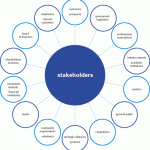 An airline company sues an online ticket provider. Fishermen from the Gulf pay a visit to an oil firm in London. An investment brokerage is accused of misleading government. Today’s headlines could be quite different if more companies embraced efforts to engage stakeholders. Why should you care about engagement? More enterprises understand that a broader spectrum of internal and external stakeholders has a direct impact on their core business. Those that have engendered deep levels of engagement – what I call strategic relational engagement (SRE) – are far more successful in shaping that impact to their advantage.
An airline company sues an online ticket provider. Fishermen from the Gulf pay a visit to an oil firm in London. An investment brokerage is accused of misleading government. Today’s headlines could be quite different if more companies embraced efforts to engage stakeholders. Why should you care about engagement? More enterprises understand that a broader spectrum of internal and external stakeholders has a direct impact on their core business. Those that have engendered deep levels of engagement – what I call strategic relational engagement (SRE) – are far more successful in shaping that impact to their advantage.
Neuroscience research supports experience that profound relationships with stakeholders are vital to business success. Other studies show how employee and customer engagement are intimately connected and, taken together, have an outsized effect on financial performance.
So, for your company to sustain its competitive advantage, SRE – multi-directional, emotionally deep, profoundly trusting relationships that unleash people’s greatest potential – is no longer an option but an imperative. Welcome to the interconnected world of business!
How can your company learn how to foster engagement?
HRE is meaningful engagement among stakeholders on boards, within line units, over country divisions and across entire organizations. Individuals become more engaged in their work and, even more, individuals become more engaged with each other through work, all of which is good for business.
In four decades of helping enterprises from all global sectors to better engage stakeholders, I have yet to encounter a situation where SRE didn’t lead to increased efficiency, stronger financials and greater fulfillment. And companies employing SRE often simultaneously deliver benefits for society, a truly mainstreamed corporate social responsibility linked to bottom line ROI.
But many companies don’t know how to effectively create or sustain SRE. By applying key elements that support HRE, business leaders can solidify the long-term success of their operations. Let’s look at how this plays out in real cases within the framework of four main themes. In doing so, I hope to inspire your imagination about HRE possibilities.
I. Creating value through SRE
To create SRE, companies must know the capabilities, conditions and processes they need.
In the mid-1970s the major logging companies, environmental activists and the California government were archenemies. But their eventual collaboration led to the creation of “Investing for Tomorrow’s Prosperity.” As a cross-sector team, they moved from reforestation to fisheries and then to all renewable resources, which became the blueprint for Global Green Plans. How did they do it?
They found individuals within each stakeholder constituency who had the capability to see beyond their own perspective. They jointly created conditions for safe dialogue by identifying inviolable principals and areas where the stakeholders were willing to compromise. They developed processes for “see-the-light-early” catalysts to lead others from their respective constituencies.
Tactics that distinguish this case’s effective use of HRE included strong bonding experiences like neighborhood tree planting parties with cookouts and dancing that allowed all stakeholders to discover the humanity of “the other.”
Companies must find at least one stakeholder who can create a trusting environment where people truly listen, hear and try to put themselves in the others’ shoes. Ultimately, all stakeholders must develop a clear grasp of the shared goals and determine how their respective goals will align. Business leaders who are able to do this will succeed.
II. Overcoming obstacles to SRE
To be effective companies must define their obstacles, identify the drivers that can overcome them and mobilize those drivers.
In 2009 when a global corporation made dramatic cuts, dealing honestly with the obstacle of extremely low morale became critical. Senior leadership found that a key driver for boosting morale revolved around initiatives showing the company’s genuine care for remaining employees. Through transparent meetings that revealed their financial reality, team members then could understand the full picture as well as openly share their personal concerns.
This broader understanding fostered a more stable environment but the company still had to mobilize catalytic leaders – those with the best skills for leveraging informal persuasion networks – to recreate trusting engagement, which they did to tremendous effect using SRE.
As this experience shows, it is vital to identify at least one person who can prevail despite a general unwillingness to find common ground. It should be someone who can forge bonds among initially unwilling parties: someone who has the skills to move among stakeholder constituencies and reward cross-boundary behavior. Business leaders who look for or cultivate those people in their companies will reap the benefits.
III. Making SRE last
To keep SRE going for the long-run companies must learn how to sustain it by determining how it might breakdown and what they can do to mend any breaches.
In 2007, after an international holding company acquired a number of related companies with the aim of benefiting from the synergies, it lost sight of the aim and each business was operating in its own silo. To sustain HRE and address the breakdown, they had to recreate an awareness of the benefits sought in the original synergy mission.
Convening the heads of all its units, the company analyzed these critical points of synergy and devised formal mechanisms to mend engagement among the businesses. Each unit in each country began to share with each other regularly and one benchmark by which they were measured was how systematically they continued these communications.
As silos are a threat to many companies, it is essential that they foster systems that strengthen ongoing connections among different cohorts, encourage open dialogue about fissures and their causes and promote ongoing transparency to regain/maintain a sense of interconnection. Those that do will have a competitive advantage.
IV. Bridging leaders as über-catalysts
Companies that leverage bridging leaders, as über-catalysts, create strong catalytic teams that drive SRE through empowering others and forming chains of trust with stakeholders.
In 2000 global activists were protesting at AIDS conferences with signs, “Coke kills workers in Africa.” Though Coca-Cola had the best policies in Africa for AIDS prevention, protection, testing and treatment of its own workers, protesters demanded that the company should provide the same services to its bottling affiliates, which were completely separate entities. Coke, however, felt it could not justify extra expenditure for its affiliates.
How could they overcome this impasse? Über-catalyst bridging leaders from all sides encouraged developing SRE through dialogue, successfully allowing antagonists to see each other as human beings who actually cared deeply about the same outcomes.
Through SRE Coke realized that serving its bottling affiliates’ employees was in its best interest; if they became infected, it would affect Coke’s entire supply chain. They also saw that the public didn’t distinguish Coke from its affiliates, as activists were negatively impacting Coke’s brand.
And AIDS activists acknowledged that while they got media coverage for blasting Coke, their attack strategy was never going to change Coke’s policies. If they really wanted workers in Africa to stop dying Coke would have to agree to transform, which required SRE.
Ultimately, Coca-Cola provided AIDS services for bottling affiliates’ employees throughout Africa with each stakeholder group – including the affiliates and employees – paying some costs.
The über-catalyst bridging leaders in this and in the other cases saw the value in SRE and were willing to come together long before others would. They then systematically brought along other catalysts to work on expanding SRE in their companies.
To compete in today’s increasingly interconnected world driven by globalization where traditional boundaries are shifting by the hour, information – accurate or not – is readily available and a 24/7 news cycle, companies must cultivate leaders who can nurture SRE for ongoing success.
And leaders must understand that SRE takes place over an arc of time with many vital steps along and often rocky path. Yet nothing beats it for long-term value creation or competitiveness. Experience and research shows that your company will thrive with SRE: it’s just a matter of when and how will you tap into it.
————————–
Nadine B. Hack, President and CEO of beCause Global Consulting and currently Executive-in-Residence at IMD in Lausanne, Switzerland, has advised The Coca-Cola Company, Omnicom Group, Unilever and other Fortune 500 companies on rethinking stakeholder engagement. This piece was published on Forbes.com, ReWiring Business, Jakarta Post , Mexico’s Inversionista and as an IMD Tomorrow’s Challenges. You can post comments here and on any or all of those sites with links to your work.

